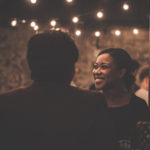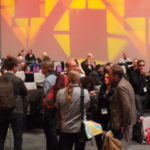
In July 2011, as Sage Summit —a customer-and-partner conference hosted annually by the global business software company Sage North America —was winding down, Danielle Cote, Sage’s vice president for event marketing, was feeling pretty good. She and her team, Cote said in a recent interview, had produced what she considered to be their finest conference ever.
For the first time, organizers had embedded RFID chips in conference badges — the chips were activated by readers as attendees moved in and out of meeting rooms, and collected data about who attended what sessions and how long they stayed. And once the RFID results were delivered to Cote, her satisfaction with the conference evaporated. The data, she said, was “gut-wrenching.
For example, while the opening keynote visually had looked as if it had played to a full room, Cote said, the RFID data revealed that “the people that we wanted to be in the room weren’t there.” In fact, only about 30 percent of conference participants had attended the session.
“We were spending an exorbitant amount on keynotes, and only a third of our audience was there to hear it,” Cote said. The obvious question was, “Why are we spending all of the money if people aren’t listening to our messages, and we aren’t building a community?”
For Cote, as team leader, it represented both a personal and a professional crossroads. There was a real question whether Sage Summit would survive. If it did, it would have to be completely reinvented. “I thought, wow, things have got to change,” Cote said. “It was either find a new path, or the company would find one for me.”
Making the Connection
Cote’s first move was to dig into feedback from Sage Summit participants. She had consistently heard from members of a customer advisory board that attendees wanted more networking – but in her view, the meeting already offered many opportunities. Special-interest badge ribbons and “Birds of a Feather” luncheons, along with meet-and-greets and receptions, brought like-minded attendees together, Cote reminded the advisory board. “They told me that wasn’t enough,” Cote said, “but they couldn’t articulate exactly what they wanted.”
Just as Cote was wrestling with how to redesign Sage Summit, she happened to attend a meetings-industry–related conference. It would be an opportunity, she thought, to connect with event planners who faced similar problems – new contacts who might help her figure out her own dilemma. But although the conference’s organizers did many of the same things Cote had done to facilitate networking at Sage Summit, none of them really worked well. “Just putting us together assumes that you will connect, but it wasn’t enough for me, either,” Cote said. “I wanted some way to deal with my exact challenges.”
Something clicked for Cote. “I realized that this was exactly what our customers were struggling with,” she said. “They wanted to connect not only by [software] products and industry, but by specific challenges and resolutions.”
At that point, she didn’t really have a strategy about how she could make that happen at Sage Summit. But she knew that she needed to find a way to create and sustain a deeper level of networking for her attendees – “Something more than what you can do,” Cote said, “over a coffee and a bagel.”
Trailblazer Wanted
Redesigning Sage Summit was a “big, big project,” Cote said, and she knew she needed help. But as she began to contact networking experts, she seemed to run into a brick wall. As she explained her goals, the people she reached out to quickly lost interest. In-depth networking might work for smaller groups, they told her, but trying to orchestrate it on a large scale, with hundreds of attendees, was destined to fail.
Only one person – networking expert Sarah Michel, CSP – was interested. “She was the only person who said, ‘I’m in, I can make this work,’” Cote said. The two later would laugh about the dispirited first message that Cote left for Michel, almost taking it for granted that Michel, too, would say no. “For anyone who hasn’t done anything new, it is really scary,” Cote said. “You need someone to be a pioneer and trail-blaze with you.”
Michel is a dynamic and compelling motivational speaker, but her interest also is in facilitating attendee interaction. She was introduced to Open Space Technology methods at a National Speakers Association workshop, she said, and “was blown away by the depth of the connections I made.” The experience convinced her to seek out additional training as an Open Space facilitator.
In that role, instead of acting as “the sage on the stage,” you are the “guide on the side,” Michel said. She added: “You give up control and you are listening more than you are speaking. It’s a totally different energy.”
Building Sage City
One of the tenets of Open Space is that attendees are self-organizing and define topics of discussion themselves, but with hundreds of attendees expected at Sage Summit 2012 – on Aug. 12–14 at the Gaylord Opryland Resort & Convention Center in Nashville – it was impractical to wait until the conference began to initiate the process. So Cote and Michel used a modified Open Space design, relying on information gathered and refined through focus groups and collected through the conference registration process. That allowed them to map out in advance what were likely to be hot topics for discussion, making the design flexible enough to allow them to create new groups on site.
Their design also included using a small army of guides whose role on site would be to help attendees connect with groups that closely matched their interests and to lead discussions. Sage invited its partners – vendors who sell the software to customers – to be trained as facilitators, through a series of webinars and in-person training programs conducted by Michel. Michel also trained dozens of Sage employees to back up the vendor facilitators.
“It really was a comprehensive process and took a lot of great effort,” said Greg Jones, a senior associate for strategy at Cramer, a Norwood, Mass.–based creative and production agency that also worked with Cote. “Our challenge was to take the [hundreds of] people in one room, and fit them into different places in the Sage ecosystem. It was very important to quickly segment rooms into smaller chunks.”
The process of breaking a large group into more than 100 different special-interest groups was a complicated one, said Cote, who credits Cramer with pulling the elements into a single concept – “Sage City” – that attendees could easily understand. Special-interest groups were divided into villages, with partner-facilitators designated as mayors. Attendees then just had to pick a village and look for a “hot topic, ” which was labeled on a lollipop-style sign.
The physical design of the meeting space also reflected the idea of a city made up of a series of villages, with a “road” – a carpeted path with a yellow stripe – circling the 55,000-square-foot Delta Ballroom at the Gaylord Opryland. The room’s décor, by Los Angeles– based event designer Roger Hampton, created a series of globally inspired environments: a beer garden strung with lights, a cantina, park benches set against a skyscraper-filled mural backdrop. And the cost of decorating the room was distributed over the entire conference – the ballroom also was the setting for an opening-night party, with a central fountain later replaced with a center stage for the opening session.
Show Time
Although Cote and her team prepared extensively for the Aug. 14 Sage City session, opening session, the outcome was ultimately out of their hands. “We have done so much planning and discussing and strategizing,” Cote said in an interview the week before Sage Summit 2012. “ We’ve done what we could – now it is up to the attendees.” Minutes before the session, Cote told her boss she needed to excuse herself for a moment – to throw up.
Convene had been invited to attend, so we were there to see how Sage City was received. Things opened with the dramatic staccato of drum notes, and then Michel took the stage, explaining the session’s structure – which had already been detailed in multiple platforms, included pocket guides tucked into every attendee badge – and introducing two short TED-style talks by top Sage executives. Michel then formally opened Sage City – fully expecting, she said in an interview before the event, a few minutes of “controlled chaos.” And there were: Music throbbed as hundreds of attendees crisscrossed the ballroom toward a sea of bobbing signs.
The center held, however, and attendees soon sorted themselves into groups of anywhere from two to more than a dozen, and the cacophony in the room settled down into a steady buzz. The plan for the two-and-a-half-hour Sage City session included a break and an invitation for attendees to choose another group to work with. Most people, it turned out, chose to stick with their initial groups. Some groups were so engaged with one another, they had to be gently shooed away well past the end of the session.
The hours of research and training paid off. Linda Schleihauf, marketing manager for IndustriOS Software Inc., in Ontario, acted as a village mayor and reported in a blog post that, although she worked with a diverse group of manufacturers and business partners, many of them had “the same common burning issues.” The process, Schleihauf wrote, gave each participant an opportunity to share his or her experience and insight in finding solutions.
One of the most successful elements of Sage City was the generation of content by the attendee groups: Organizers printed oversized “outcome cards,” with spaces where key takeaways could be written. The cards had adhesive tags on the back – think jumbo Post-It notes – so they could be easily stuck to walls provided for that purpose.
The sticky notes stayed up in the ballroom, where breakfast was served every morning, giving attendees a chance to learn from conversations they themselves had not participated in. And Sage City delivered a benefit to the company – a pool of data outlining customer needs and issues, Cote said, that will help drive product development. The company is compiling the session’s business solutions into a digital archive and plans to share them back with customers.
There was one big surprise: In addition to the low-tech handwritten takeaway cards, Cote’s team had expected that Twitter would serve as a primary communication tool and, by way of a conference hashtag, as a conduit for ideas. But the Twitter stream slowed to a crawl during the Sage City session. “That was largely due to the fact that people were actually talking to each other,” Jones said. “Everyone put their phones and tablets away.”
After the session, however, the conference’s social-media channels “lit up,” Cote said. Weeks after Sage Summit, blog posts filled with takeaways from sessions continued to circulate. In previous years, there were always a couple of days of congratulatory messages – and then nothing, Cote said.
Another positive year-over-year change was that Cote could look at conference data without getting a sick feeling in her stomach. By the time of the opening session, about 1,000 attendees were checked in to the conference, Cote said. Of those, 63 percent participated in Sage City – more than double the level of participation from the previous year.
Beyond the immediate boost in attendance, the larger gain is the creation of connections and communities that are lasting beyond the meeting, Cote said. And one of the biggest successes is the executive support gained for Sage Summit. Leaders are “more excited than ever about what this program can mean for the company.”
A Place for Everyone
When planning for Sage City, organizers expected and made plans for those attendees who had a tendency to stand back a little from group activities – an estimated 25 percent of the total. A video feed was displayed on a monitor in a low-key social-media and networking lounge set up just outside the ballroom, where couches and armchairs stayed occupied throughout the Sage City event.
Organizers also took pains to make sure that discussions were structured to allow everyone to speak, and distributed flyers with a few best practices, including “Practice active listening” and “Encourage others to share their experience.”
“Our group had a couple of quieter individuals,” reported participant Linda Schleihauf. “But with the format used, they were comfortable sharing, and more importantly had an opportunity to do so. The group was very focused and worked hard to collectively discuss alternatives, and was very respectful of what each person had to contribute.”
More Resources
For a look at Sage City through the eyes of Patricia Tynan, Sage’s social media and community manager, visit convn.org/sage-city.
Danielle Cote and Sarah Michel will present an experiential “Sage City” case study at PCMA 2013 Convening Leaders. To learn more, visit conveningleaders.org.
Innovative Meetings is sponsored by the Irving Convention & Visitors Bureau, irvingtexas.com.



